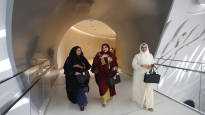France’s 12 million schoolchildren started their school year yesterday, Monday. The Minister of Education also took effect on the same day Gabriel Attali an order banning the wearing of the abaya, worn by Muslim women and girls, in school premises.
Abaya is a long, loose dress that covers the body from the neck to the feet, including the arms. Muslim women often wear a headscarf with it to cover their hair in accordance with religious regulations.
According to French law, the state is very strictly separated from religion. The country wants to keep school premises non-religious. The principle is known by the French term laïcité.
On this basis, the country already adopted a law in 2004 that prohibits visible religious symbols in schools. At that time, Christian crosses, Muslim women’s headscarves, Sikh turbans and Jewish kippahs were banned in schools.
The French government has stated that abaya dresses are also a religious garment, which is used to circumvent the ban on religious symbols in some schools. There are about 45,000 schools in France, but violations of the rule occur in about 500 of them. Special attention is to be paid to them.
At the same time, the long robes worn by men, known as khamis, are banned.
Misunderstanding or discrimination
Minister Attali’s order has raised a heated debate. The political left says the government has bowed to pressure from the right.
In France, especially the extreme right has wanted to extend the ban on religious clothing to all public appearances. For example, a far-right leader Marine le Pen has demanded a complete ban on headscarves. There has also been a desire to set a requirement for non-religious dress for parents accompanying their children to school.
The extreme left, on the other hand, considers the abaya ban racist, anti-foreigner and anti-Islam.
– That [määräys] will cause a lot of problems, a lot of difficulties, when school principals have to answer an impossible question. What is an abaya? How does it differ from other long clothes, asked a member of parliament from the far-left La France Insoumise party Paul Vannier.
The women of African descent interviewed by French television FRFT do not consider the abaya a religious garment. They think it’s just good for warm weather.
– I wear an abaya because I like it. I don’t think it’s a religious garment. A veil is, it is a religious garment for me, but not an abaya.
For some, the banning of the abaya has become a reason to wear the abaya.
– That [abaya-kielto] is a show of contempt that I cannot tolerate. That’s exactly why I want to wear an abaya always and everywhere, said the student Imane in the online publication Middle East Eye.
Some, on the other hand, are ready to give up the abaya in order not to disturb their studies.
– I don’t want this clothing issue to negatively affect their studies by stigmatizing them because of a piece of cloth, whether it’s religious or not, said the mother of three schoolchildren to Middle East Eye Rokaya.
Macron: The rule will not be compromised
President of France Emmanuel Macron has defended the regulation against criticism. According to him, the rule is followed without compromise.
– Our schools are non-religious, free and compulsory. That is, non-religious. This is a condition that enables citizenship, and because of this, religious symbols of any kind have no place in them, he stated.
According to Minister of Education Attali, the order will not be extended outside the school.
– There is a difference between what happens in schools and outside of school. What matters to me is what happens in schools.
Scarf bans are rare
France is the only one of the EU countries where there are country-wide regulations on headscarf bans in schools, he says Euronews.
There is no uniform regulation in Britain, but the Ministry of the Interior has given schools the right to issue their own regulations in their instructions if there is a justified reason for them.
In Germany, states have been given the power to regulate headscarves in their own regions. Policies vary. In some states headscarves are prohibited in schools, while in others they are allowed with certain restrictions. Some states want at least the face to be visible, some also require the hair to be visible.
Muslim-majority Kosovo has already banned headscarves for students in 2010.
In Italy, right-wing populist politicians have been discussing banning headscarves in schools. However, it is difficult to enact the ban without discriminating against Muslims, as Catholic nuns often teach in Italian schools, and their clothing includes a headscarf.
In Finnish schools, there are no regulations on religious costumes.
Test whether you recognize Islamic accessories:
